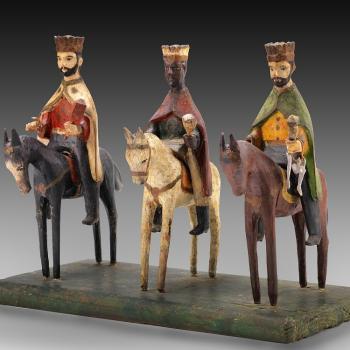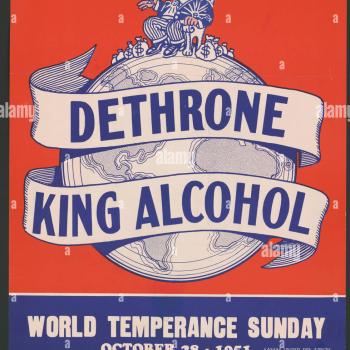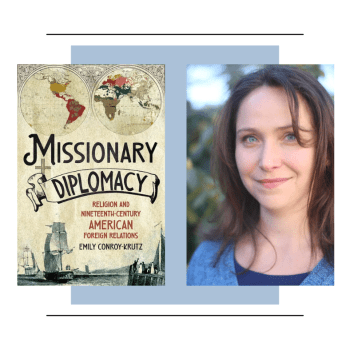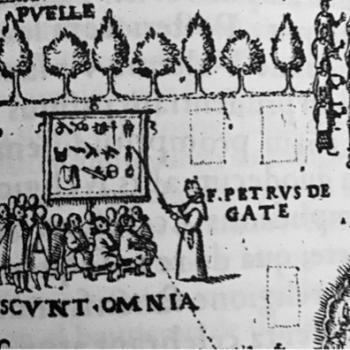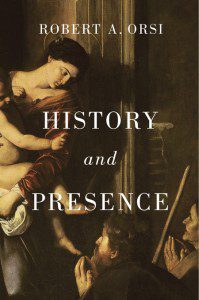 “After he has lunched on his God on Sunday, / You should worship his turd on Monday.” So the French Huguenot polemical poet Agrippa d’Aubigné mocked the Catholic Eucharist. Early Protestants felt and feigned horror at the idea that Catholics believed that they chewed, swallowed, and digested the very body of Jesus Christ. They were cannibals (“papal anthropophagy,” per John Milton). They were théochèzes, or “God-shitters.”[1]
“After he has lunched on his God on Sunday, / You should worship his turd on Monday.” So the French Huguenot polemical poet Agrippa d’Aubigné mocked the Catholic Eucharist. Early Protestants felt and feigned horror at the idea that Catholics believed that they chewed, swallowed, and digested the very body of Jesus Christ. They were cannibals (“papal anthropophagy,” per John Milton). They were théochèzes, or “God-shitters.”[1]
It was a bit harder to mock absence than presence, but Catholics responded in kind. Christ had instituted a sacrament, not a symbol. No real presence, no grace, no salvation. Or, as the eponymous hero of the 1933 Catholic novella Tony explained to group of anti-Catholic toughs, “Protestants say … that they ain’t no one there.” For many Catholics, the Protestant denial of transubstantiation was tantamount to a denial of God.
Historian Robert Orsi begins History and Presence with the Eucharistic debates of the sixteenth century. He ends with a meditation on the tragedy of clerical sexual abuse. Along the way, Orsi immerses his readers in a series of “abundant events”: miraculous healings, visions of the divine, encounters with the demonic, and countless moments of devotion.
Through his analysis of these “abundant events,” Orsi asks historians and other scholars of religion to revisit the presuppositions or methodologies that guide their research and writing. He laments that “modern theories of religion were written over accounts of the gods really present, submerging them in a theoretical underworld, while on the surface the gods were reborn as symbols, signs, metaphors, functions, and abstractions.” In other words, Protestant and post-Enlightenment scholars have done to narratives of religious experience what Zwingli did to the Eucharist.
By contrast, Orsi contends that the study of religion “ought to be the study of what human beings do to, for, and against the gods really present … and what the gods really present do to, for, and against humans.” By “gods,” Orsi means “all the special suprahuman beings” to whom humans have related. In their study of what he terms “abundant events” of supernatural presence, scholars should study the past and the present with “the gods as interlocutors and provocateurs, as agents of both the given and the impossible, as malignant spirits, as harbingers of excess, as the ones who hold the memories that individual humans and entire societies forget, as bringers of succor and pain.” Protestant, Catholic, or none of the above, few scholars write about religion in Orsi’s bracing manner.
Of course, rather than asserting that God was absent from the world, many Protestants denied that God and other sacred beings were present in objects. Christ was with humans in spirit, for example, but his resurrected body remained strictly in heaven. Orsi does not offer any detailed analysis of the way that Protestants — despite their theologies — perceived the divine in objects, ranging from Oral Roberts’s prayer cloths to the Bible itself. In any event, he is correct that in the wake of the Reformation “Catholicism became the paradigmatic religion of real presence,” the bogeyman of “superstition” among Protestants. For Catholics, Christ was not trapped in heaven. He was present in the consecrated Host, in which his bodily sacrifice continued. The divine, furthermore, was viscerally present in the world, in the relics of martyrs, in the blood and tears that oozed from statues, even in printed objects with pictures of saints.
Protestant and Catholic authorities both found divine presence difficult to manage. “Presence forever exceeds the bounds set for it,” Orsi observes. Protestants eventually brought religious imagery back into their churches and adorned them with crosses. Meanwhile, while Catholic reformers adopted longstanding Protestant critiques of “superstition” and attempts to purge churches and shrines of material excess, those devoted to the saints, to the Virgin, and to the Sacred Heart of Jesus often carried on with practices that made hierarchs cringe.
Orsi wants to teach scholars not to mimic that cringing. He takes us to the bedside of a graduate student diagnosed with an incurable form of leukemia. Why did this student choose to make a pilgrimage to Chimayo before receiving a bone marrow transplant? At the time, the shrine was full of notes, photographs, and the canes, crutches, and eyeglasses pilgrims have discarded as a testimony to their healing. The clergy has since sanitized the room, reports Orsi. The student tried to bring a Ziploc bag of Chimayo dirt into the bone marrow transplant unit. The doctors refused, but she would not proceed without it. The hospital eventually compromised, sealing the dirt within an additional plastic bag. For this student, for the other pilgrims at Chimayo, the dirt was “the physical reality of the gods become close.” Zwingli would have seen idolatry in this behavior. Nineteenth-century scholars might have understood the bag as a fetish, as a Catholic superstition. For the student and for Orsi, though, the bag did not merely symbolize the divine presence. The bag of dirt was “the presence of the supernatural really there.”
Through the supernatural really there, humans also experience fear and agony. The material also made evil real. It was present in those Catholic priests who sexually abused children. As Orsi explains, “being abused by a priest was to be abused at one degree of separation from God.” Parents taught their children to obey priests and frequently defended priests against their own children’s discomfort or accusations, and predator priests took full advantage of their sacred authority. One priest told his victim that receiving his semen was “another way of receiving Holy Communion.” Many victims stayed away from Mass, which increased their sense of divine absence and internal suffering. Some found God’s presence in the company of fellow survivors.
Many scholars have a knack for twisting religion into something unrecognizable to those who have experienced it. Thus, Marian visionaries become “fully constituted and anticipated within the discourses, technologies, and vicissitudes of power in the social worlds of modern France and global Catholicism.” Rather than actually bracketing off ultimate claims, such epistemologies presume that individuals have not experienced what they claim.
History and Presence is abundant, even excessive, in its ideas and prescriptions. It bursts with the presence of Christ, the Virgin, and the saints. Orsi asks us to take risks. “The past,” Orsi warns, “may act upon us in such a profound way as to erase our intentions of remaining outside of it.” Perhaps more so than historians, a good number of anthropologists have encountered the supernatural beings of the cultures they have studied. Even the divine presence in human history, though, has the potential to challenge and shape those who write about it.
It is easy to object to Orsi’s proposal. It is not the job of historians, believing or not, to ascertain whether or not supernatural beings exist and, if so, how they are or are not present in the world. At base, scholars have no immediate access to the religious experience of others, only access to narratives that those individuals tell or write. We are at least one step removed from the gods whose presence Orsi wants us to acknowledge.
How, though, might one faithfully report and analyze those narratives? In a manner akin to Orsi’s approach, David Haberman in his chronicle of northern India’s Ban Yatra pilgrimage asserts that the objective “historian of religion … brackets judgmental considerations and accepts all realities as potentially valid.”[2] Orsi goes a step beyond such bracketing. He weaves the real presence of the divine and demonic into his stories. That presence is palpable in History and Presence.
Perhaps that is an appropriate starting point, but at times a measure of skepticism seems inescapable. Must one accept Joseph Smith’s account of golden plates? May one not question the credulity of those who buy prayer cloths or access to pilgrimage sites? Orsi privileges the experience of the supernatural over such skepticism. Most historians keep a more measured distance from their subjects, which keeps the supernatural at arm’s length.
An implied presumption of divine absence, though, also carries great risks. It impedes our ability to understand individuals, past and present. If we do not recognize that the gods are present in much of our world, Orsi concludes, we will “miss the empirical reality of religion in contemporary affairs and … fail to understand much of human life.”
Building upon Orsi’s argument, one might ask that if religion is not something “sui generis,” if religion is only a “second-order, generic concept” (as Jonathan Z. Smith has rather persuasively argued),[3] if religion merely symbolizes patterns of power, hierarchies, and language, then the game might one day be up. If the gods are not present, perhaps we will no longer need “scholars of religion.” Chew on that for a while.
Flannery O’Connor once went to a dinner party hosted by formerly Catholic writer Mary McCarthy. McCarthy shared that contrary to what she had been taught as a child, she now understood the host as a symbol. “Well,” rejoined O’Connor, “if it’s a symbol, to hell with it.” Robert Orsi rather politely says the same thing to theories of religion that strip the unpredictability, contingency, and excessiveness of the divine out of human history.
Note: for those interested in further discussion of Orsi’s History and Presence, there’s a fabulous series underway at The Juvenile Instructor. See the first installment here.
[1] Susan Juster, Sacred Violence in Early America (Philadelphia: University of Pennsylvania Press, 2016), 25-26.
[2] David L. Haberman, Journey through the Twelve Forests: An Encounter with Krishna (New York: Oxford University Press, 1994), 169.
[3] Jonathan Z. Smith, “Religion, Religions, Religious,” in Mark C. Taylor, ed., Critical Terms for Religious Studies (Chicago: University of Chicago Press, 1998), 281.








